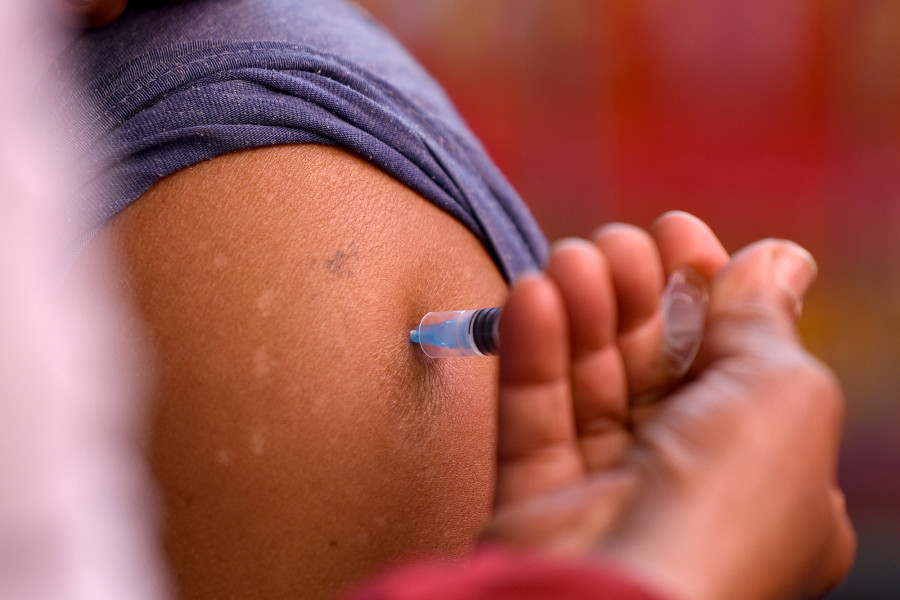Health
Ministry mulls vaccinating workers who come in frequent contact with public
Bankers, transport staff and public utility workers, among other priority groups, to get the vaccine.
Arjun Poudel
The Ministry of Health and Population is likely to start inoculating people who provide various services to the general public, from Saturday.
Under the programme, people working in banks and offices related to revenue, telecom, drinking water, electricity, transport and security will now get the vaccine, according to officials. However, people on the first priority list, who couldn’t get the jab earlier due to various reasons will not get the vaccine during the new campaign.
“We are yet to make a decision. But we do hope to start the new immunisation drive from Saturday,” Dr Shyam Raj Upreti, coordinator for the Covid-19 vaccine advisory committee, told the Post.
Officials said that over 200,000 people will get the vaccine from the remaining doses.
“The remaining doses of Covishield vaccine provided by India under grant assistance will be used to immunise the rest of the frontline workers, serving in several public offices.”
Of the one million doses provided by India, the government still has 700,000 left, according to officials. The ministry has decided to reserve around half of the doses from the stock to provision for the second dose for people who have already received their first dose.
“We are working on plans to inoculate even the elected representatives in local governments and civil servants,” an official at the Health Ministry, told the Post, asking not to be named. “For the elderly people, we will provide vaccines only from the next consignment. It will not take much time for the next batch of vaccines to arrive.”
India provided one million doses of the Covishield vaccine, developed by the University of Oxford and pharmaceutical giant AstraZeneca and produced by the Serum Institute of India, under grant assistance on January 21.
The Health Ministry rolled out the vaccines on January 27 targeting 430,000 frontline workers, including health workers, supporting staffers at health facilities, female community health volunteers, sanitation workers, elderly people living in old age homes and prisoners.
But only 184,857 people took the jab under the first phase. The number is only around 43 percent of the targeted group.
The Health Ministry then started inoculating people serving in diplomatic missions and journalists from Monday using the remaining doses. Neither staffers from diplomatic missions nor journalists were on the predetermined priority list.
“We will continuously run the immunisation campaign, as we won’t face problems to immunise people as per the priority we set,” Mahendra Prasad Shrestha, chief Specialist at the Health Ministry, told the Post.
According to Shrestha, the World Health Organization has said it will supply 2.25 million doses of Covishield by the end of February under its COVAX programme.
The Chinese government has assured to supply 500,000 doses of one of its vaccines. The UN’s health agency will provide around 10 million doses in various phases.
Public health experts suggest that the government prepare plans to increase the vaccine acceptance rate.
“This time too a top-down model (a federal agency deciding where to set up the immunisation centers) has failed the immunisation programme,” Dr Arun Kumar Koirala, a public health expert, told the Post. “Instead of deciding the location from the center, we should ask local governments to make the call to increase the coverage rate.”
According to Koirala, a lot of frontline workers were deprived of jabs in the first phase, due to inaccessible immunization centers. “Had we let the local governments decide where to set up the immunisation centres, more people would have taken the jabs,” Koirala, also a professor at the Pokhara University, added.
Officials at the Health Ministry concede flaws in planning.
They said that the target number was estimated as per the number of licences issued by different professional councils such as Nepal Medical Council, Nepal Nursing Council, Nepal Health Professional Council, and Nepal Pharmacy Council, without ascertaining their exact number. Female community health volunteers, sanitation workers, prisoners, senior citizens residing in old age homes, and security personnel deployed in the management of the dead were also counted, but officials concerned did not bother to check if everyone in these groups were eligible to take the jabs.
“We will extend the number of immunisation centers to the community in the upcoming programmes,” Dr Samir Kumar Adhikari, joint spokesperson for the Health Ministry, told the Post. “We will try to set up the immunisation booth at the place, from which we can cover the maximum number of people of the targeted group.”
Adhikari however, said that the final decision regarding the start of another round of vaccination is yet to be taken.




 11.12°C Kathmandu
11.12°C Kathmandu














